1lumen selects and reviews products personally. We may earn affiliate commissions through our links, which help support our testing.
Olight i3E EOS review
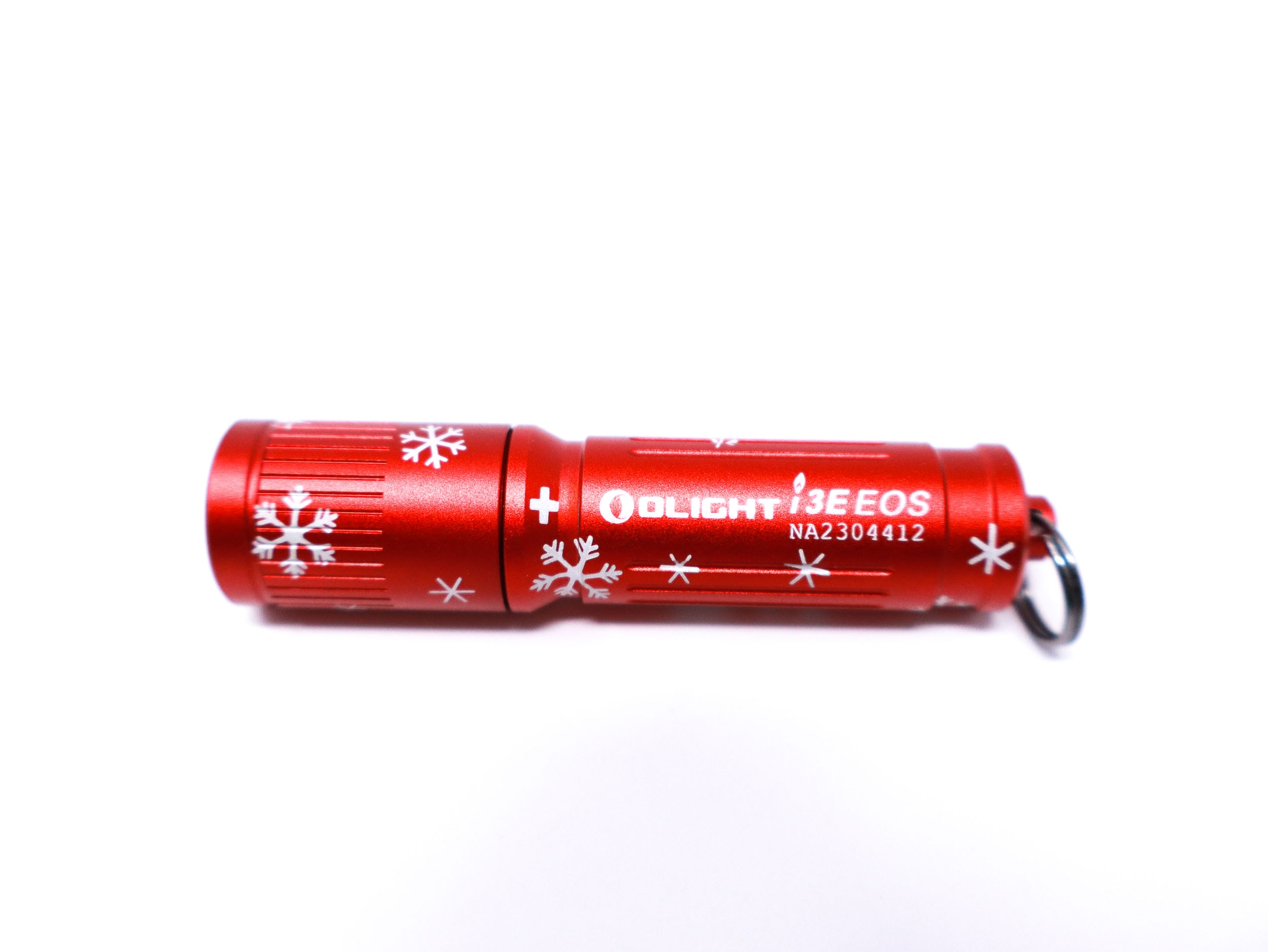
Olight i3E EOS specs
| Brand & Model | Olight i3E EOS |
|---|---|
| Flashlight category | Keychain Light |
| LED | Philips Luxeon TX |
| Max. output | 90 lumens |
| Max. beam distance | 44 meters |
| Max. beam intensity | 500 cd |
| Battery config. | 1*AAA |
| Onboard charging | None |
| Main modes | 1 |
| Blinkies | None |
| Waterproof | IPX8 |
| Review publication date | January 2024 |
Review intro:
When Henry Ford launched his Model T in 1908, his goal was simple: To make an automobile cheap enough that an average (e.g. middle class) Jane or Joe could afford. Well, he succeeded, and for a little over $550 (in 1912-about $18,000 in 2023 money), you could get yourself an automobile. At a time when lots of people were still riding in horse-drawn buggies, the Model T was a game-changer. Over 14 million of the Model T were sold from 1908 to 1927 when production ended. It could be argued that the Model T was the most influential item of the 20th Century.
So what’s the flashlight equivalent of the Model T? Some might say those disposable eBay and Jungle Site zoomies, but this reviewer gives the nod to the Olight i3E EOS. For the unaware, the ‘I’ series are Olight’s AA or AAA powered tube lights, and Olight (by their estimation) has sold over 1,000,000 of these things, which makes sense because they practically give them away as promotional items. These are cheap (not the bad kind), but totally legit micro keychain flashlights that punch way above their weight class.
Package quality.
Even for their cheapest light, Olight still gives you a nice, presentable package for the i3E EOS. It’s a nice cardstock box with a pull tap to open it up. Inside is a pull out tray holding the light and an instruction manual. That’s it.
- Olight i3E EOS
- Generic AAA alkaline battery
- User manual
This is a complete kit. Olight sticks an isolator between the cell’s positive output and the driver, which is smart to keep quiescent current down and prevent the cell from leaking. It’s not a cheap battery either, but a decent alkaline cell. I’d immediately pull it out and replace it with a good rechargeable NiMH though.
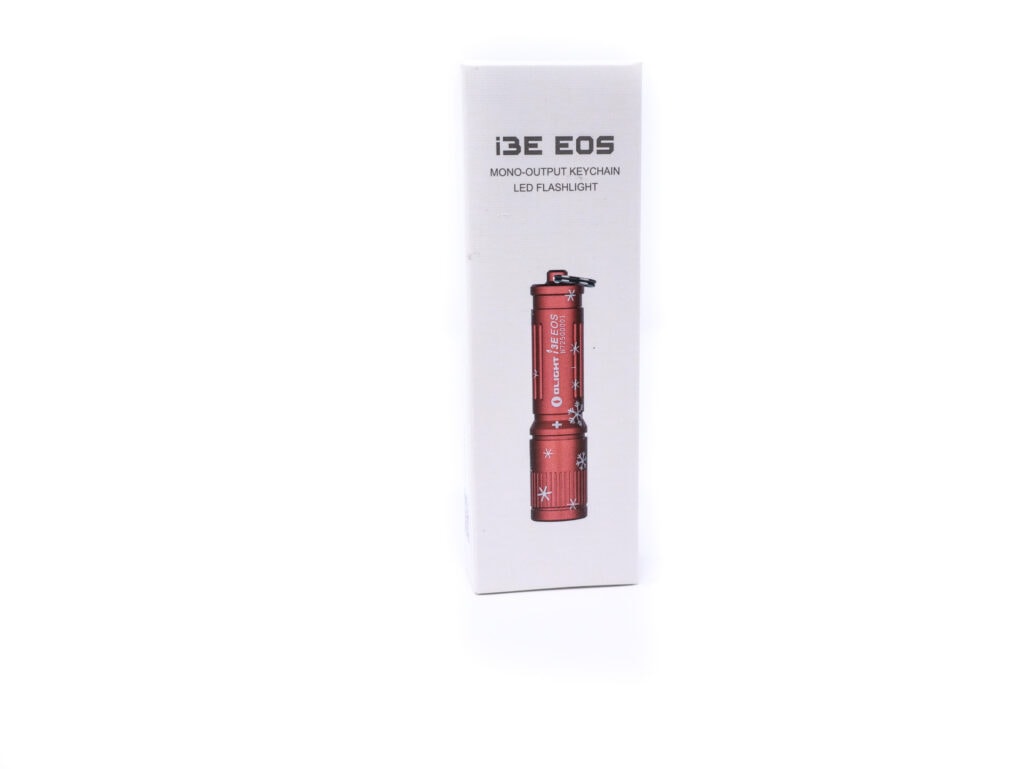
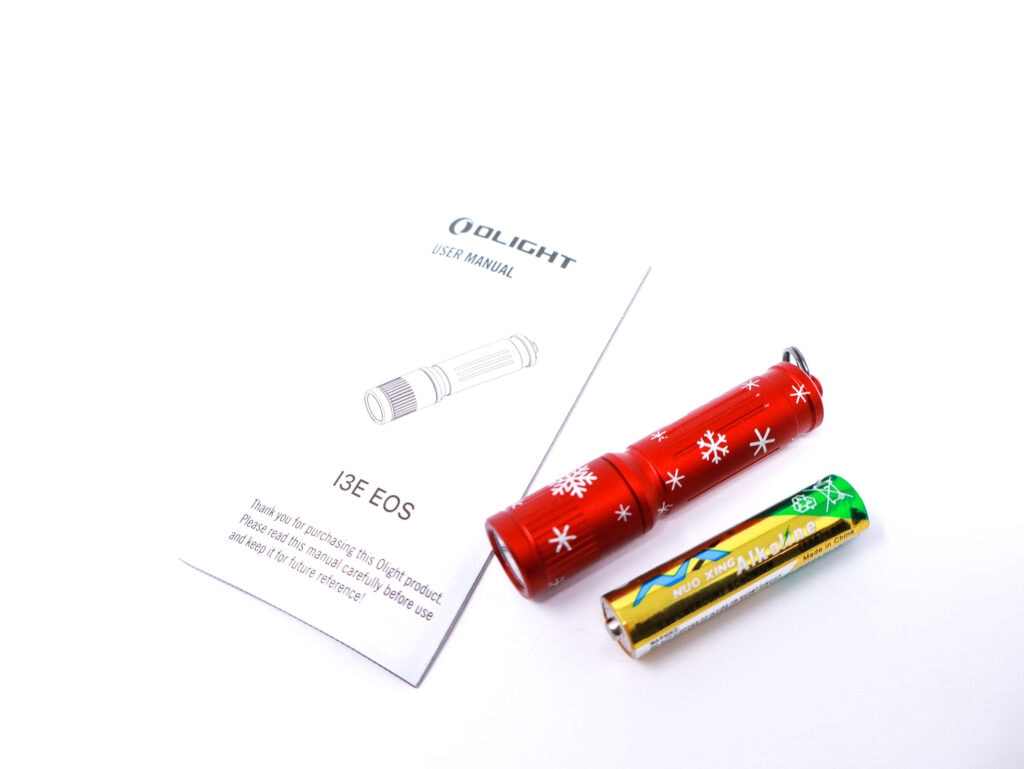
Flashlight in use, Build Quality, and Warranty
The i3E EOS is a keychain light and that’s it’s main mission, but it’s also a superbly handy emergency light that can be tossed in the drawer of shame, your glovebox, center console, desk, cubby, purse, back pack, makeup kit, what have you. It’s tiny and pretty much disappears wherever you put it. It’s roughly the same size as my pinky finger and comes in around 19 grams…with a battery inside. That’s very light…lighter than the all-plastic Fenix E-Lite.
Handling? Yah, you can, but I found myself holding it like a cigarette. This is a single-mode twistie light, and you have to twist the head to turn it on/off like the i2R and i1R EOS lights. It’s easy to do it one-handed, and the twisting action has enough resistance and smoothness to make it a pleasant experience.
Out back, there’s an integrated eyelet for the installed split ring to attach to your keychain or lanyard or whatever you fancy, and the split ring is sturdy spring steel that didn’t bend or deform even when yanked on. The head has milled grooves for gripping, and the body does too, and depending on which version you get (there’s umpteen versions of this thing), it’s either straight, spiral, or some other kind of texturing/grooves. Either way, it’s easy to grip.
Every Olight I’ve reviewed has been top-notch in build quality, fit, and finish. I have never had a quality issue or complaint with any Olight. I’ve gone through at least 4 of these and each one was repeatedly good quality. Price? If you don’t get it free, the i3E EOS is around $10.
The i3E EOS is milled from high grade aluminum alloy, and the machining, fit, and finish are flawless with no misaligned parts, gaps, or blemishes. Everything’s super tidy and the edges are all chamfered and smoothed. The silkscreen text and laser-etched graphics are crisp and sharp with nice contrast against the finish. As mentioned, the i3E EOS comes in tons of colors and patterns, coinciding with Olight product launches or sales events.
This tester came with the Seeker 4 and is the ‘holiday themed’ version for Christmas. It’s red anodized with white graphics, and I’m not sure if it’s type III HA, but it’s a nice semi-matte finish that looks nice. The finish on the i1R Pro on my other keychain is holding up okay, but it is pretty beat up and missing anodizing after 11 months of keychain duty.
The head unscrews to load the battery, and there’s a long, really bouncy coil spring at the end of the tube and a flat contact on the driver. There’s dual o-rings sealing the head and Olight says the light is good for IPX8, not the better IP68, but still good for 1.5 meter drops and full (temporary) immersion protection.
Olight’s warranty is the best in the industry: 30-day no-hassle returns and a as of January 2023, lights sold in certain markets (US, EU) get a lifetime warranty. From Olight: If you purchased an Olight® product from the USA after January 1st, 2023, the local service centers will honor your LIFETIME WARRANTY for your purchase. If your Olight product (including its structure, built-in battery, LED, or lens) ever experiences any issues, we promise to take care of it. If we are unable to repair your product, we will promptly replace it with a product in perfect working condition, which will be of equal or better physical condition. If your purchase is a limited or discontinued edition of Olight product, we will repair or replace it with another Olight product of the same or higher value. We will warrant all Olight products that exhibit any defects in material and workmanship under normal use. However, please note that this LIFETIME WARRANTY does not cover loss, theft, deliberate damage, or cosmetic damage. Even after-warranty support is generous with a 30% discount for a replacement item. Rechargeable batteries are covered with a 2-year warranty!
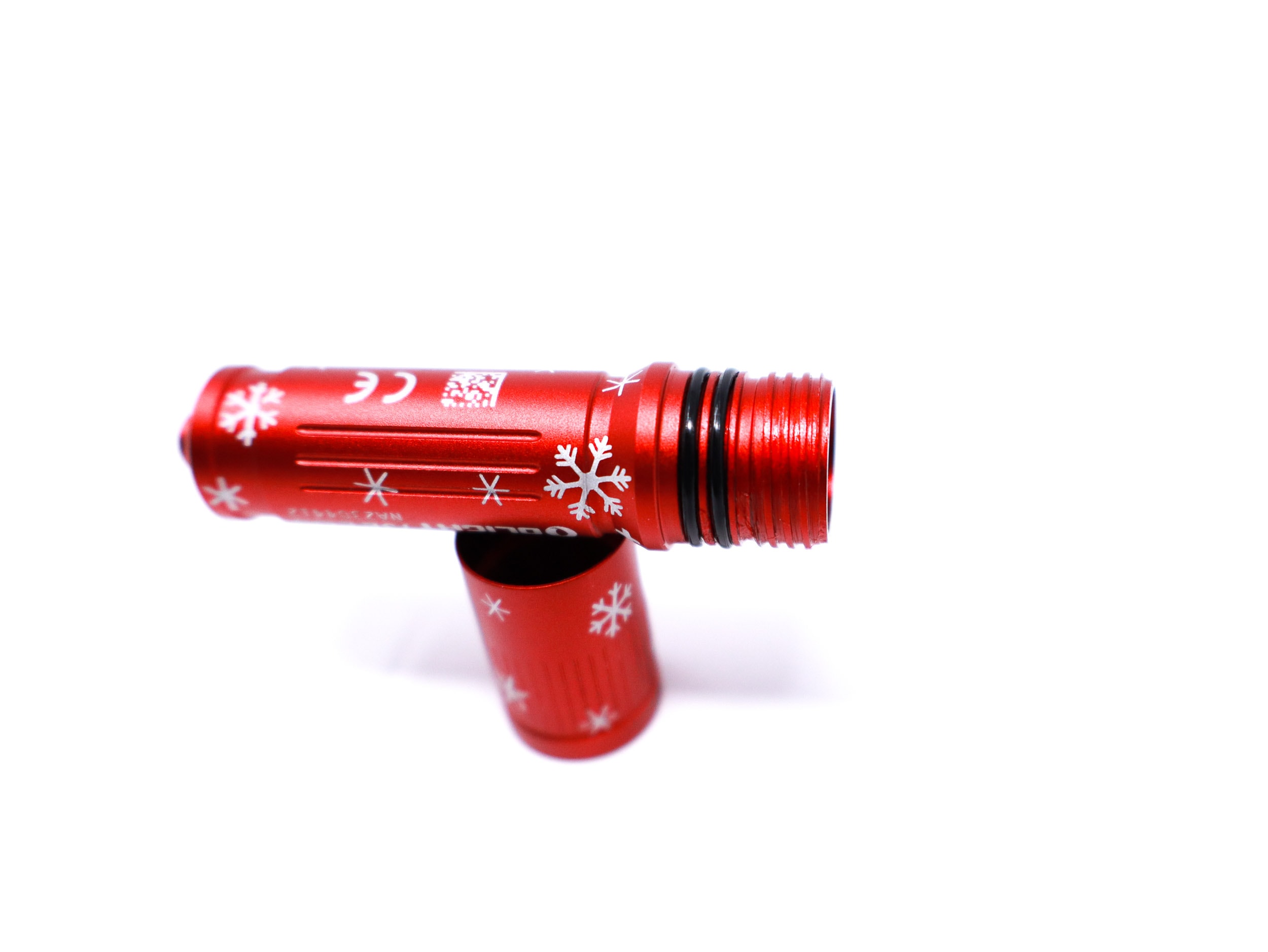

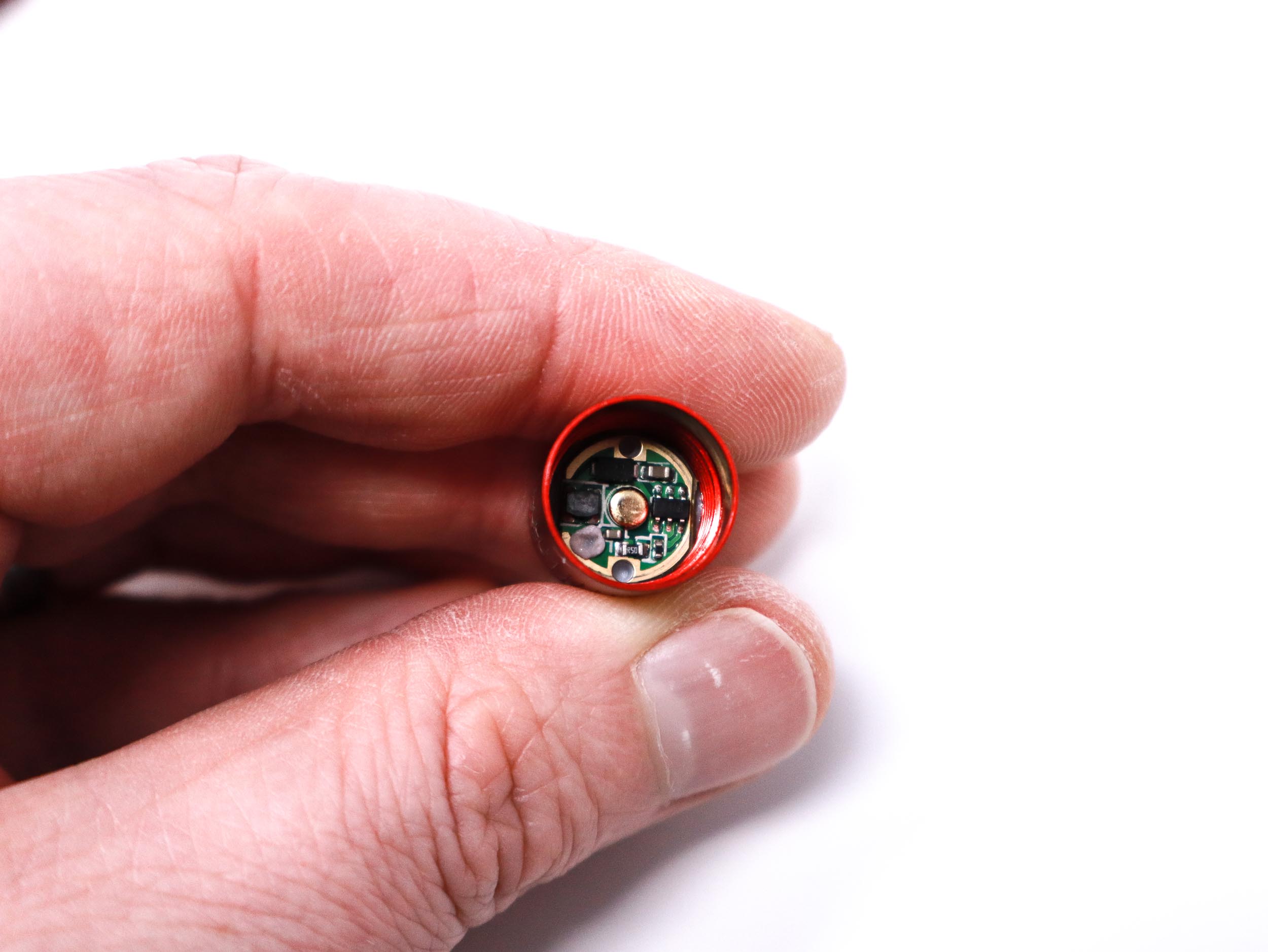
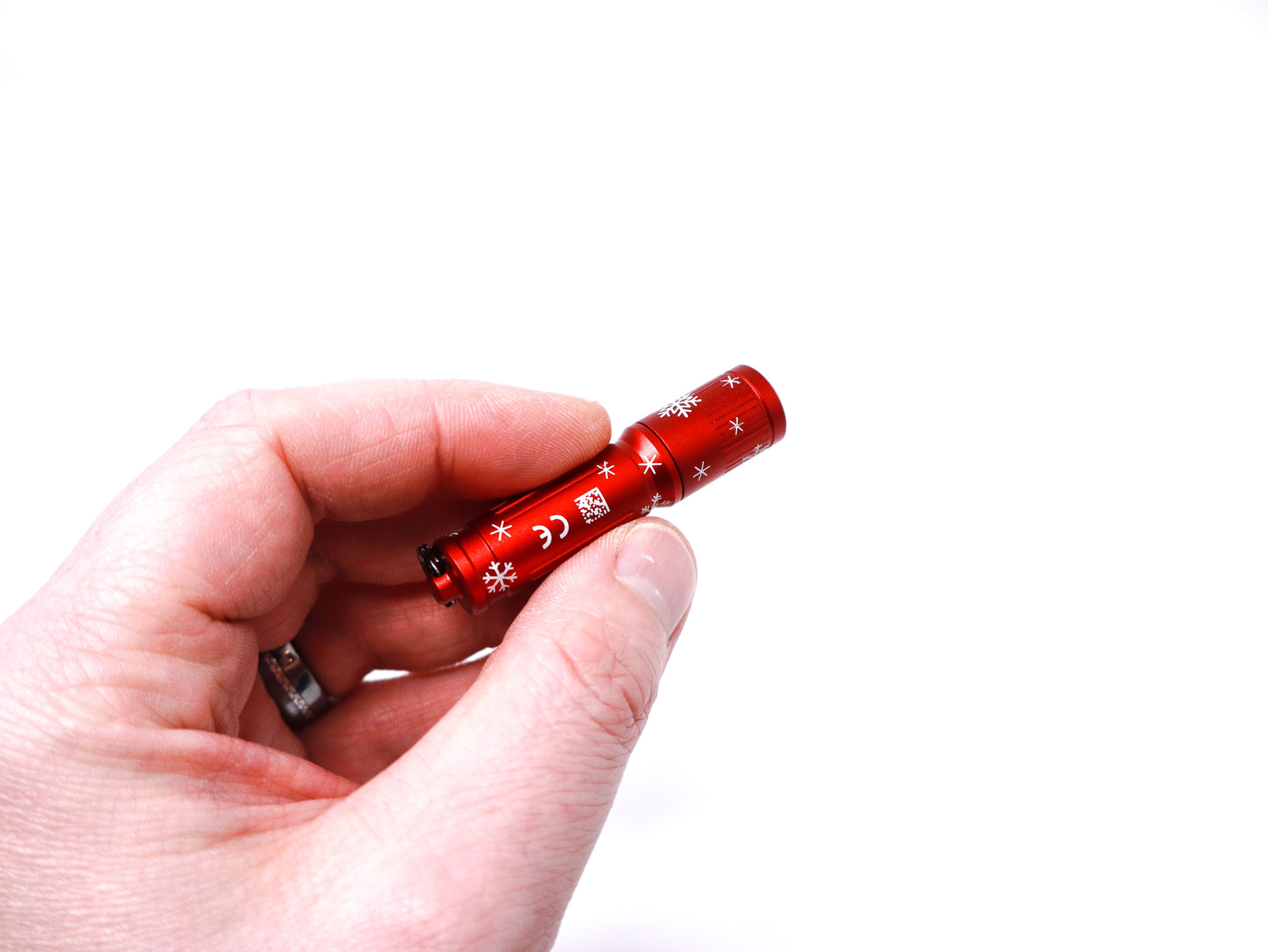
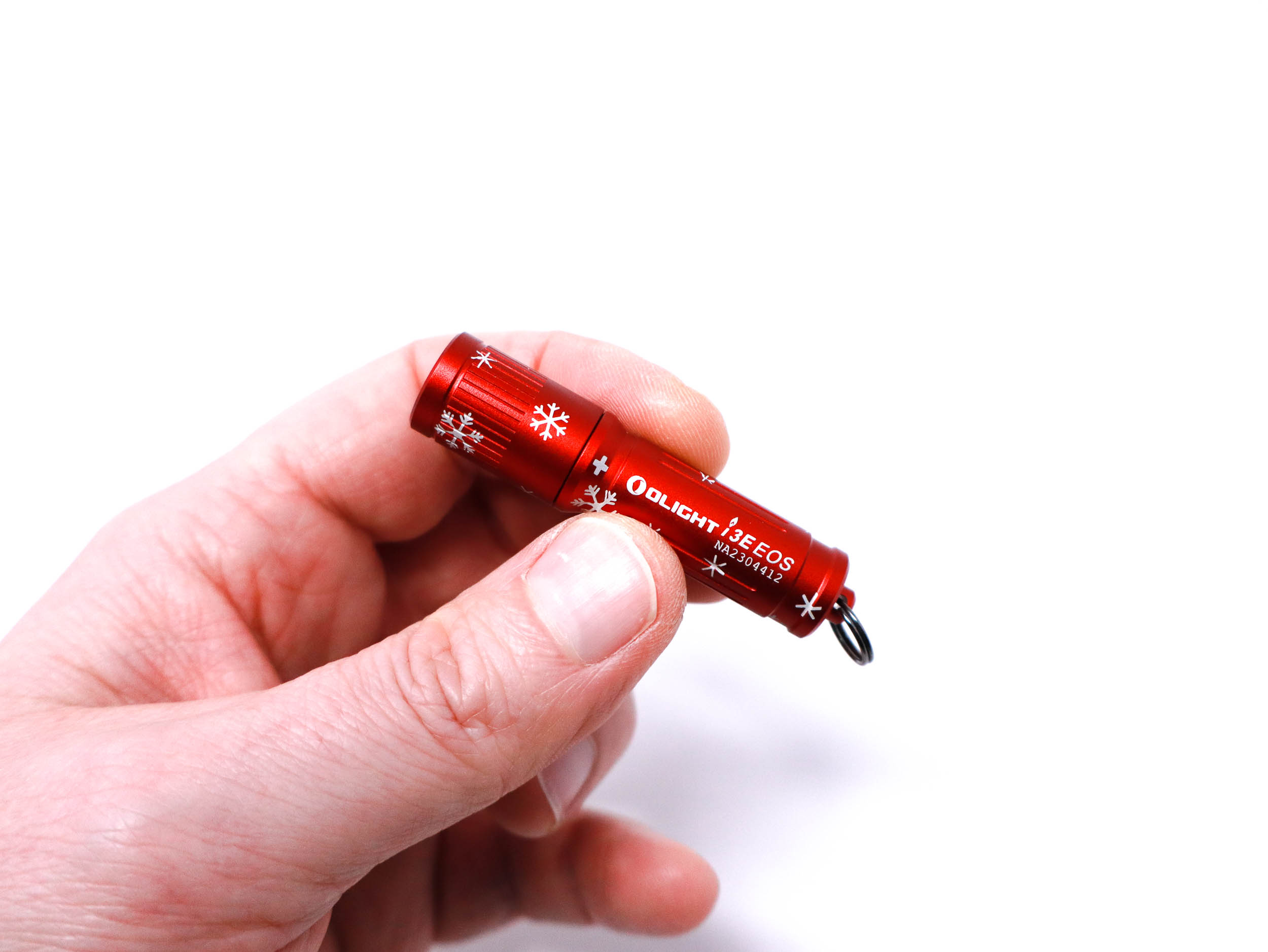
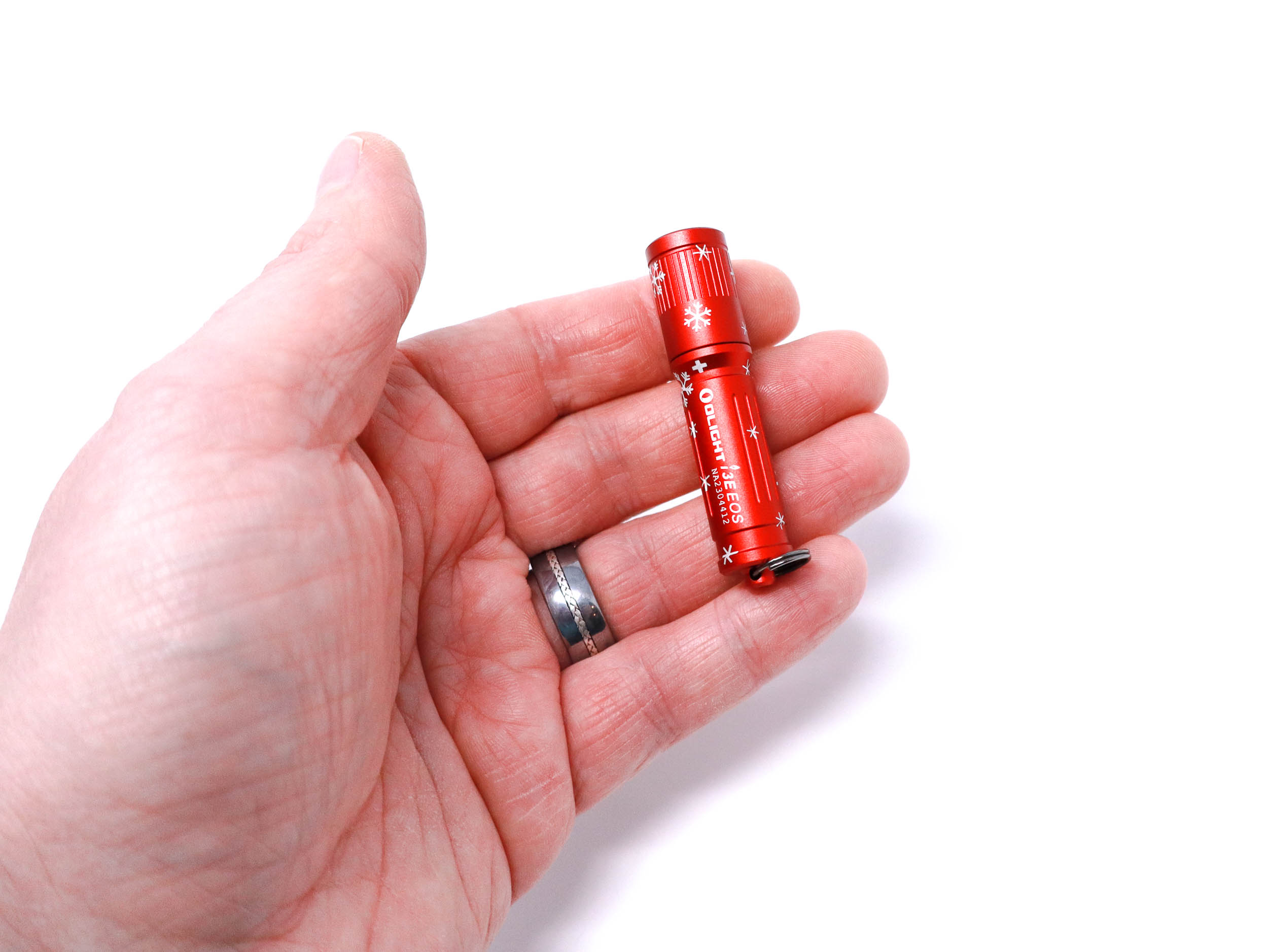
LED, Lens, Bezel, Beam, and Reflector
Okay, everyone who knows Olight knows you don’t get LED specifics. However, for the i3E EOS, Olight spills the beans. The advertised LED is made by Philips Lumileds and it’s their Luxeon TX LED. This LED has been around since 2019 and is a very versatile one, comparable to the Cree XP-E2. it’s a domed, flip-chip (CSP no exposed bondwires). It’s a 3737 (3.7×3.7 mm format-same as the Osram P9) so a bit bigger than the XP-series and SST20 LEDs, good for lower-power applications.
It’s cool white only for this application, but the LED comes in 2700K-6500K up to 90 CRI (hint, hint, Olight). The lens is a PMMA plastic TIR, sort of a hybrid like we see with other Olights. The beam is a big, wide hotspot of light with little side illumination, but it’s still more than enough for the jobs the i3E will be called to do. I say it’s about as good as it gets for a keychain light, and I like it as much as the Fenix E-Lite current occupying my keychain. There’s no bezel as the head is one piece, but it does extend about 1 mm over the optic to afford it some protection.
Spectral measurements:
I used the Opple Lightmaster Pro to measure the flashlight at 1 meter from the sensor.
| Mode: | CCT: | CRI Ra: | duv |
|---|---|---|---|
| On | 5632K | 69.1 | 0.0090 |
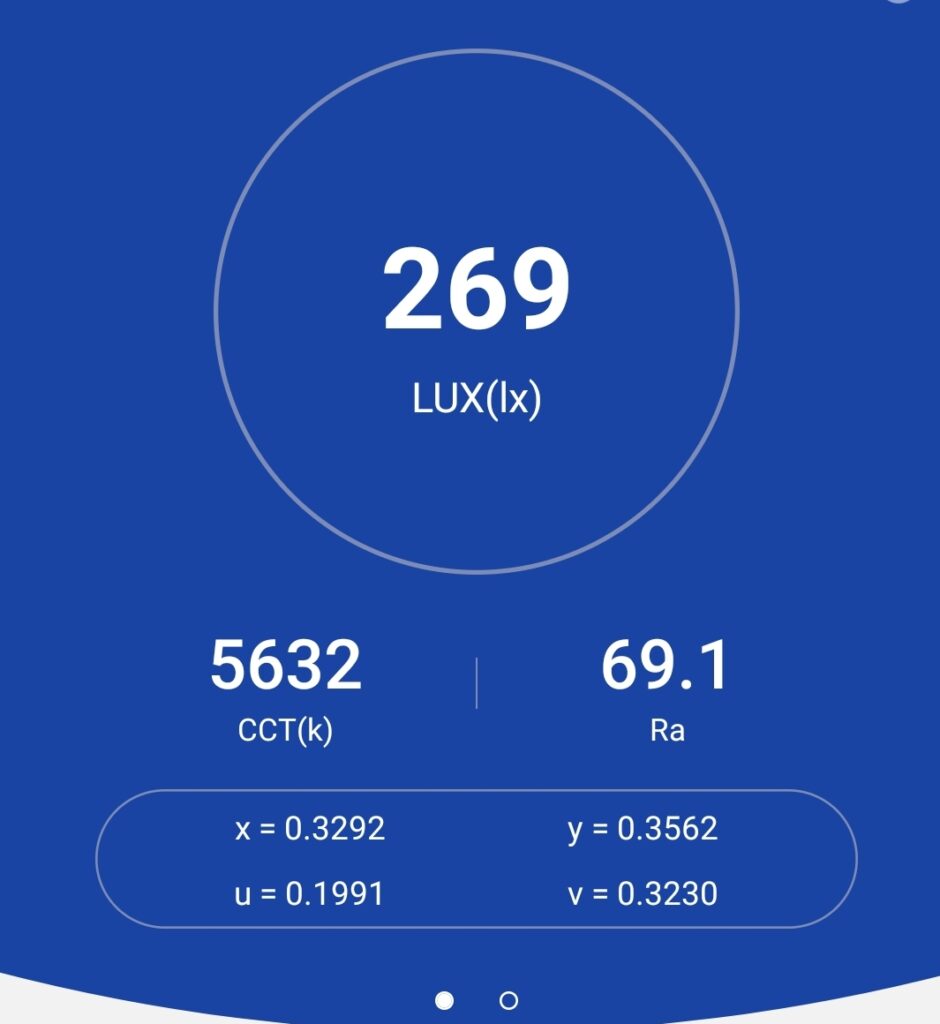
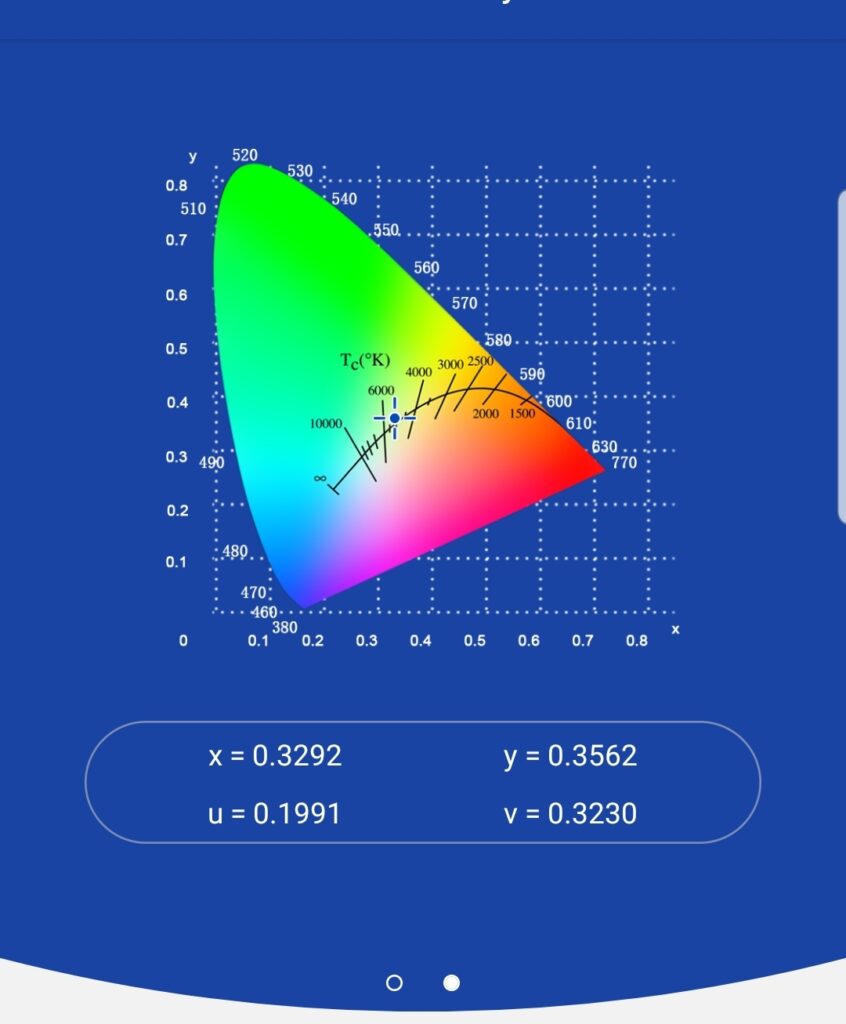
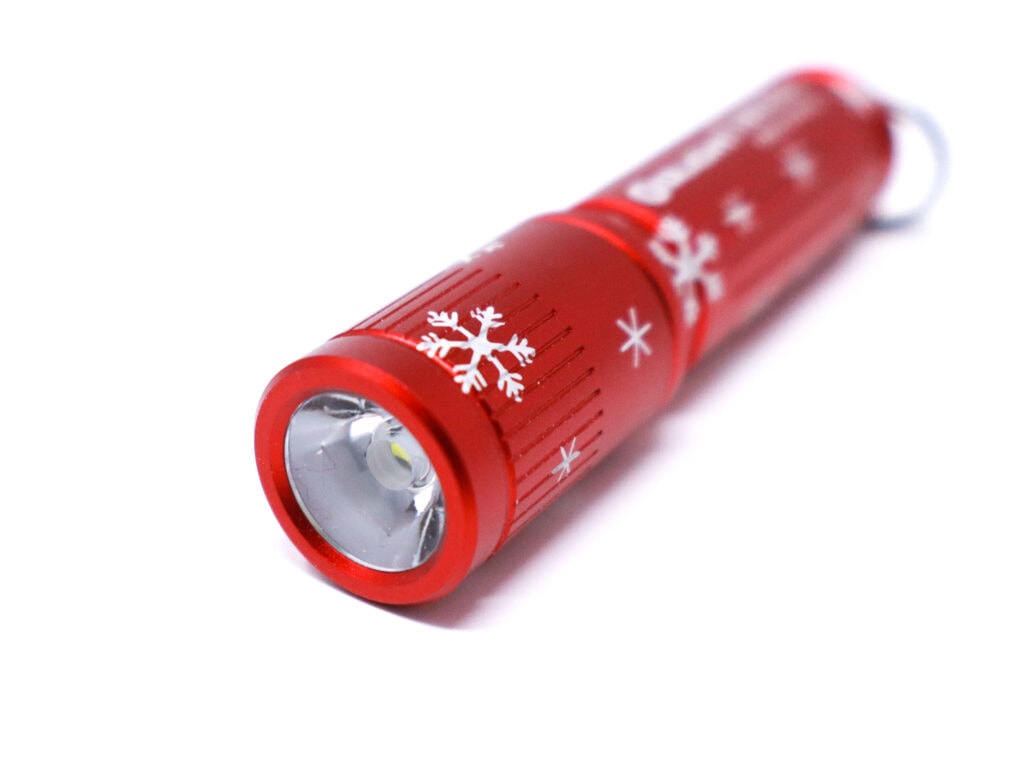
Dimensions and its competition
Dimensions:
| Olight i3E EOS | Millimeters | Inches |
|---|---|---|
| Length | 60.5 mm | 2.4 in |
| Head diameter | 14 mm | 0.55 in |
| Body diameter | 12.5 mm | 0.50 in |
Dimensions are rounded to the nearest millimeter, and to the nearest tenth of an Inch.
Weight:
The i3E EOS is very light, even with a Nimh
| Olight i3E EOS | Weight in grams | Weight in oz |
|---|---|---|
| Without battery: | 7 g | 0.2 |
| With IKEA Ladda 900 mAh NiMH battery | 20 g | 0.7 |
| With included alkaline battery | 19 g | 0.7 |
Weight is rounded to the nearest gram, and to the nearest tenth of an Oz.
Flashlight size comparison with its competition:
Group 1 left to right: Killzone Flashlight BLF348, Cyansky M2, Olight Warrior Nano, Olight i3E EOS, Olight i3T EOS, Thorfire PF01
Group 2 left to right: Fenix E09R, Lumintop FWAA, Olight i3E EOS, Look SK03, Streamlight KeyMate, Fenix E03R V2
Group 3 left to right: Olight i3E EOS, Streamlight Keymate, Olight i1R Pro 2, Cyansky M2, Fenix E-Lite
Group 4 Reflectors left to right: Fenix E03R V2, Cyansky M2, Olight i3E EOS, Killzone BLF348, Olight i3T EOS
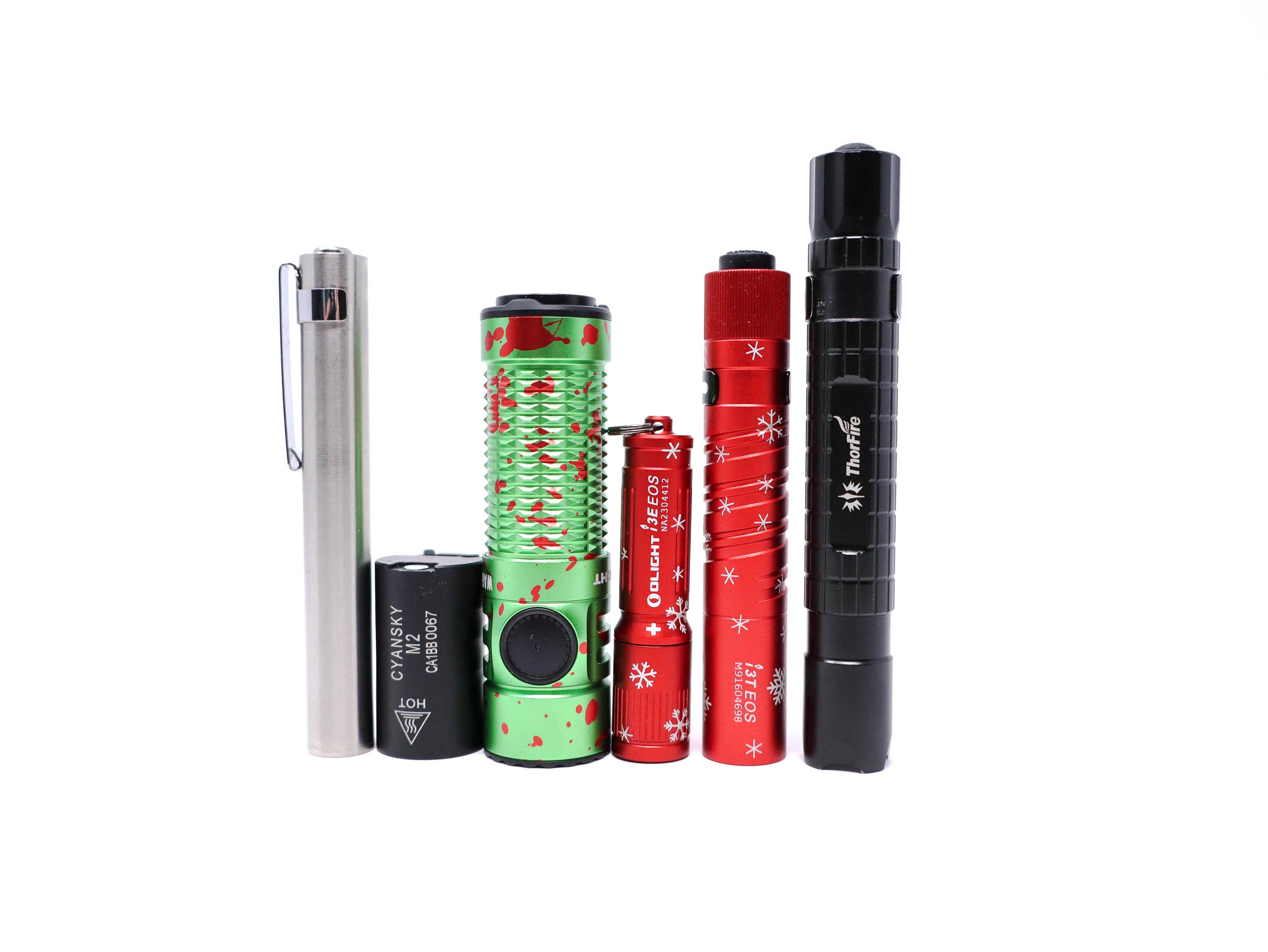
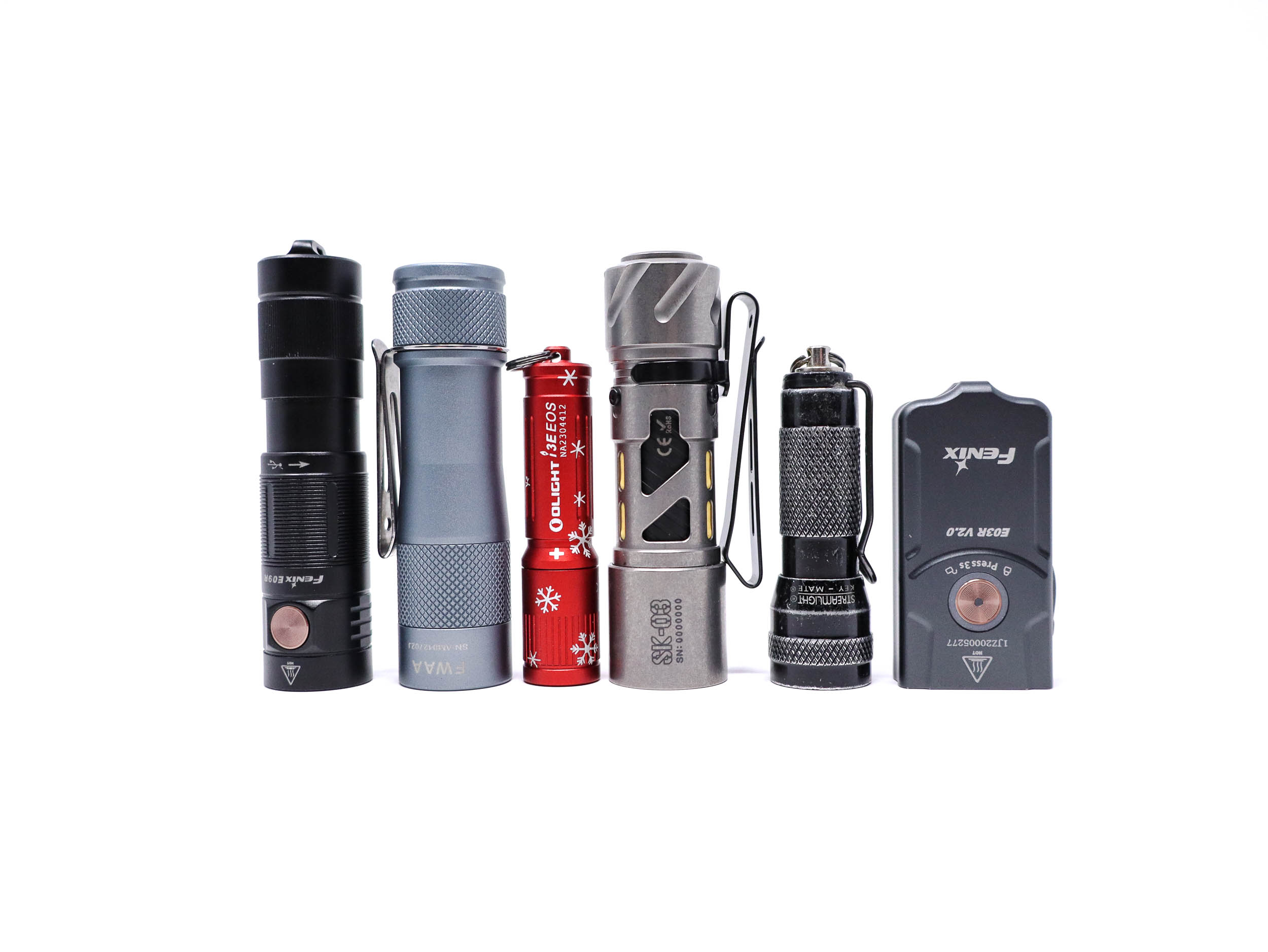
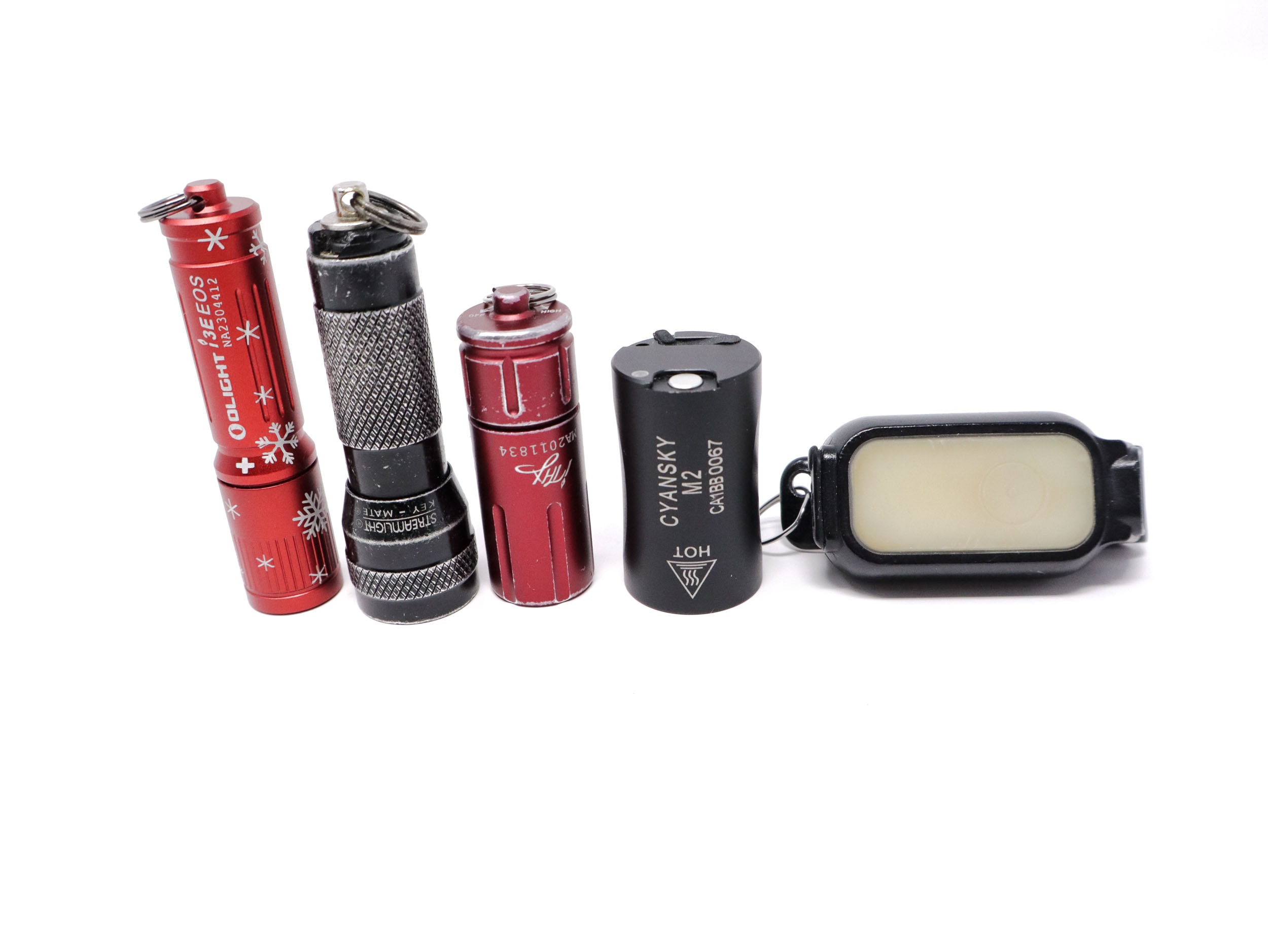
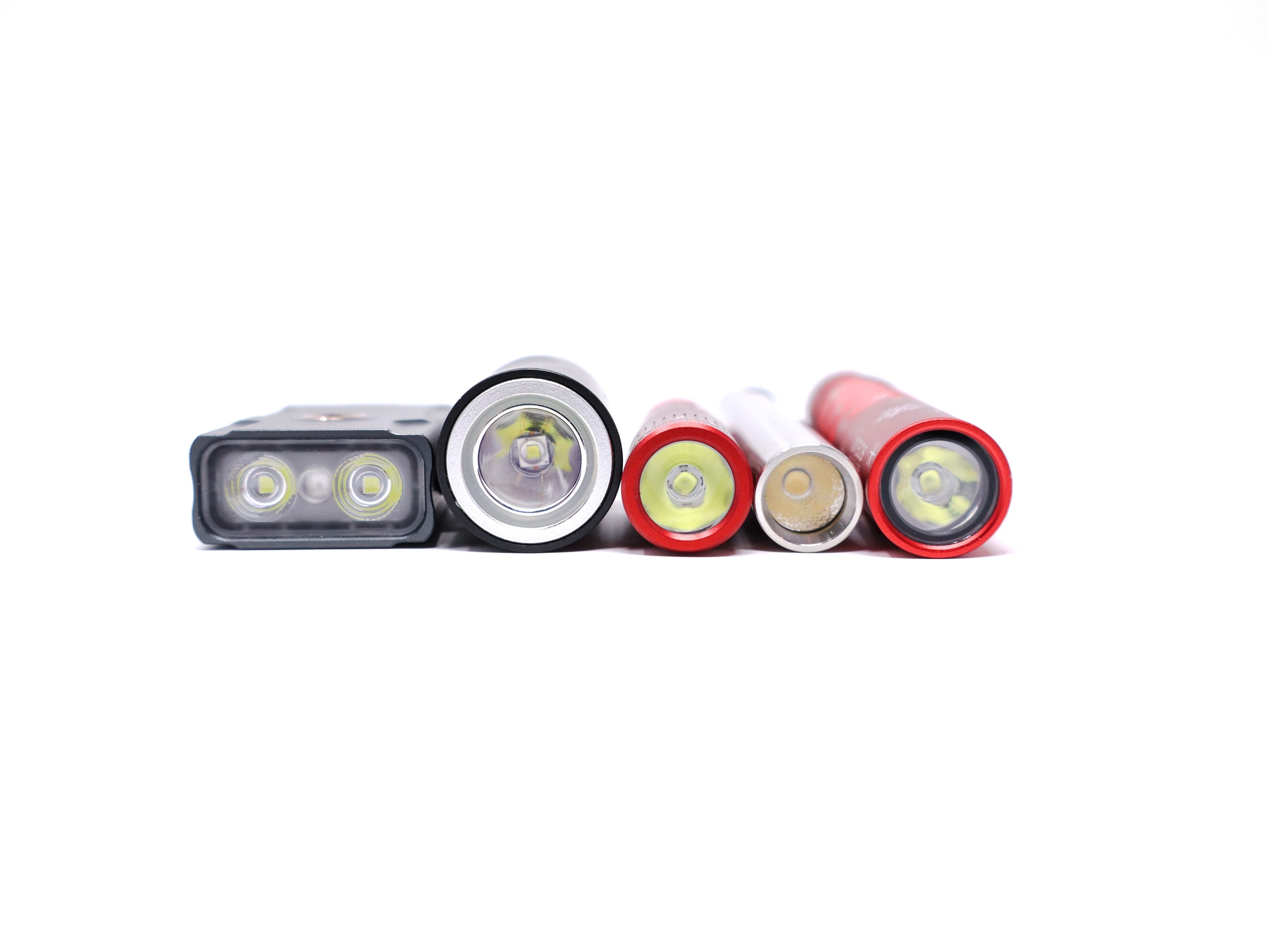
Olight i3E EOS UI: User Interface and Driver
The driver is not mentioned, but typical of Olight, it’s going to be a boost driver since the LED needs 3 volts input and a single, fresh AAA is 1.5 to 1.6 volts.
The UI? Well, it has one if you can call it that: Twist the head counterclockwise or clockwise to turn it on or off and nothing in between.
Available modes:
- On or off
Available blinky modes:
- None
From OFF:
- Twist head ½ turn counterclockwise: Turns on
From ON:
- Twist head ½ turn clockwise: Turns off
Mode memory:
- None
Shortcuts:
- None
Low voltage warning/protection:
- None, but the light keeps getting dimmer and dimmer as the battery drains with an alkaline and NiMH cell, eventually shutting down
Strobe/blinkies
- None
Lock-out mode:
- None
PWM
- None visible by eye
Additional/summary info on the UI:
- This is about as simple as it gets! A monkey could figure this one out, and if cats and dogs had opposable thumbs, they’d probably be able to use the i3E EOS. Twist on, twist off…wax on, wax off…okay seriously, it’s perfect for a keychain light since it keeps it lightweight and tiny, and one-handed use is possible and easy! The regulation is…well, sort of there on both battery types. The Nimh is able to maintain constant output longer due to the lower internal resistance and better current-handling.
Olight i3E EOS Charging and batteries
The i3E EOS is a single AAA flashlight. It can take any chemistry of AAA except a li-ion 4.2 volt cell. I haven’t tried a 10440 cell in it, and can’t confirm if anyone else has, but do it at your own risk since it might kill the driver. Alkaline, NiMH, Nicad, and 1.5 v lithium primaries work fine. No onboard charging to see here folks!
| Charge type | Fits | No fit | Charge time |
|---|---|---|---|
| None | Any AAA alkaline, NiMH, Nicad, or 1.5v lithium primary cell | 4.2 volt 10440 li-ion rechargeables | N/A |
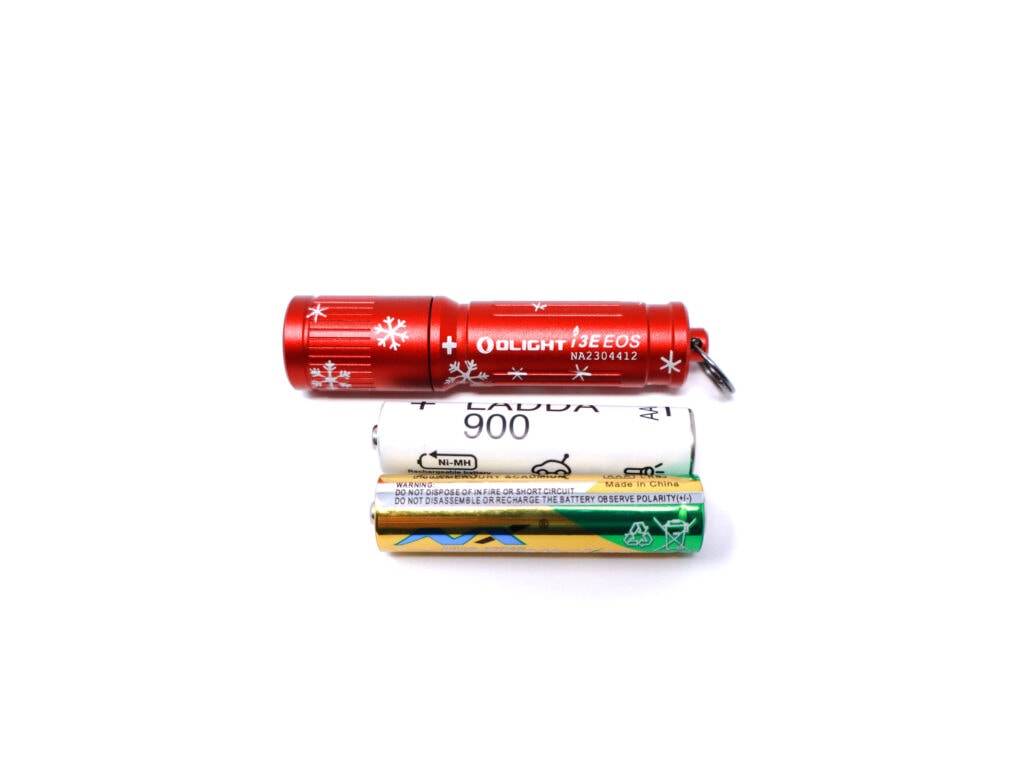
Performance test
Lumen measurements
How Lumens are Measured: Understanding ANSI FL1 Standards How Lumens are Measured: Understanding ANSI FL1 Standards: The ANSI FL1 standards specify that output in lumens should be measured 30 seconds after turning on, as this is the standardized time for measuring brightness according to the industry standard. This is why we focus on this part in our measurements. The ANSI FL1 standards require an ambient temperature of 22 ± 3°C. We record the ambient the ambient temperature to identify potential reasons for any observed discrepancies.Lumens are measured in my 50 cm integrating sphere with a Digi-Sense 20250-00 data logging luxmeter. The sphere has been calibrated with a Convoy S2+ measured to 260 Lumens and the figures are within 10% of actual. No current measurements due to the design of the tailcap and isolated current path. Measurements were taken using a fully charged IKEA Ladda 900 mAh NiMH cell and the included generic AAA alkaline cell.
| Mode | Specs | turn on | 30 sec | 10 minutes |
|---|---|---|---|---|
| On IKEA Ladda NiMH | ? | 116 lm | 116 lm | 115 lm |
| On included alkaline | 90 | 117 lm | 114 lm | 102 lm |
Parasitic drain:
- N/A
The outputs track the factory specs nicely and I’m coming in higher than advertised. This is great output from a tiny flashlight! By comparison, the Killzone BLF348 revision only makes about 40 Lumens on a NiMH cell, and the li-ion Fenix E-Lite on High does 150 Lumens. This is more than enough output for a keychain light.
Olight i3E EOS Battery Life: Runtime graphs
How Runtimes are Measured: Understanding ANSI FL1 Standards About ANSI FL1 runtime standards: The runtime is measured until the light drops to 10% of its initial output (30 seconds after turning on). This does not mean that the flashlight is not usable anymore. The last column shows how long the light actually works till it shuts off. If there is a + symbol, it means that the test was stopped at that particular point, but the light was actually still running. This happens on certain occasions, with certain drivers, firmware, or batteries.Lumens are measured in my 50 cm integrating sphere with a Digi-Sense 20250-00 data logging luxmeter. The sphere has been calibrated with a Convoy S2+ measured to 260 Lumens and the figures are within 10% of actual. I use a Digi-Sense 20250-92 data logging thermocouple for the temperature measurements. The probe is affixed to the head using kapton tape and uses the same 5 second sampling rate for logging. I used a fully charged IKEA Ladda 900 mAh NiMH cell and the included generic AAA alkaline cell.
| Mode | Specified runtime | Measured runtime ANSI | Time till shut off |
|---|---|---|---|
| On IKEA Ladda 900 mAh NiMH | *1h 10min | 1h 20min | 1h 20min |
| On included generic alkaline | 45min | 49min | 49min |
*Olight’s specification with an unidentified NiMH
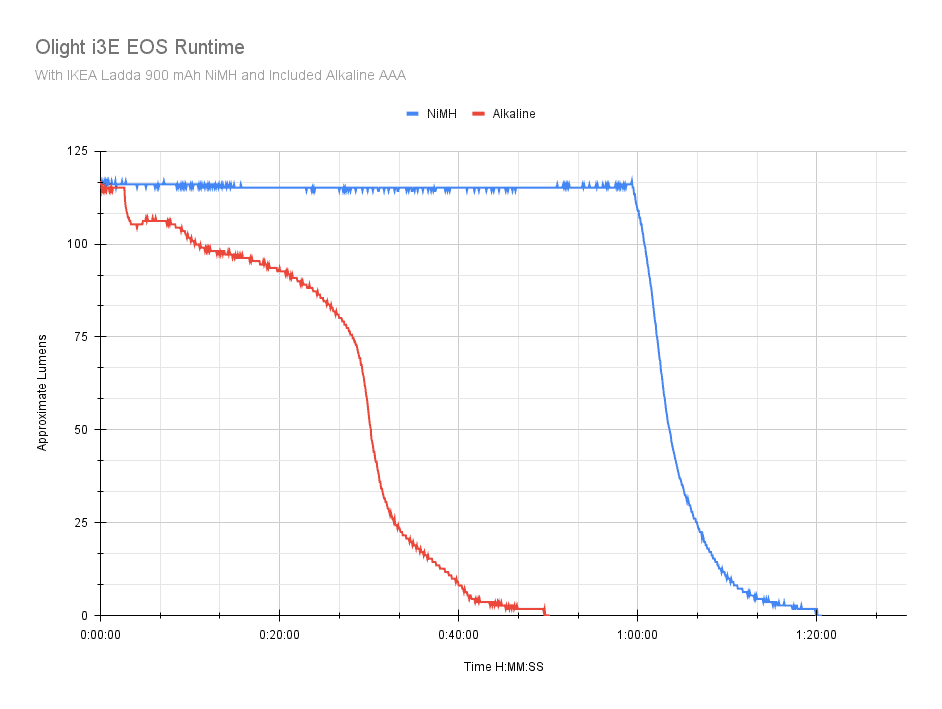
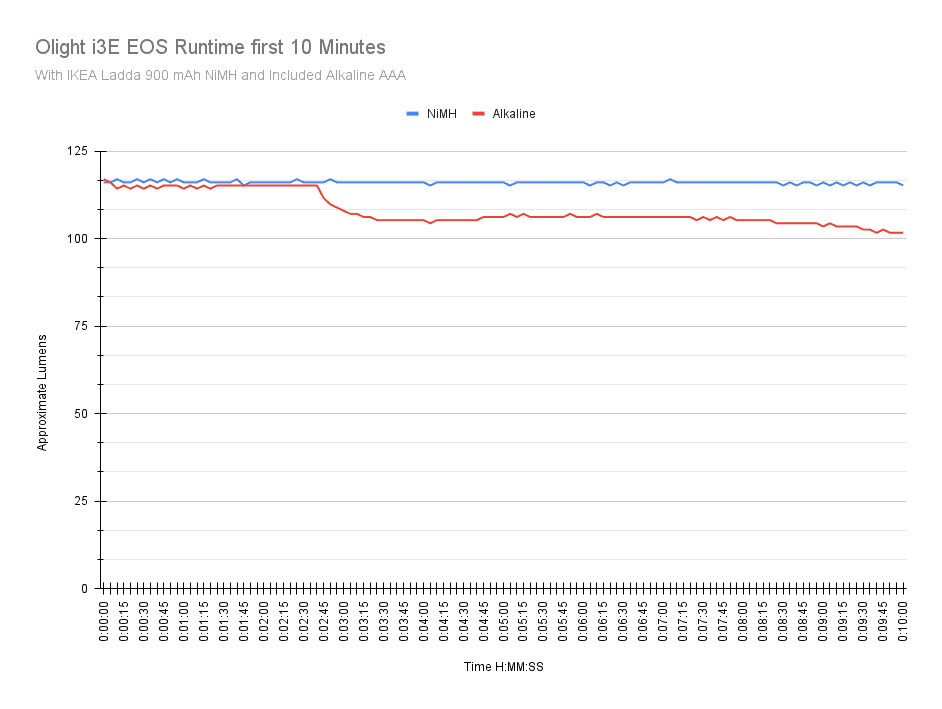

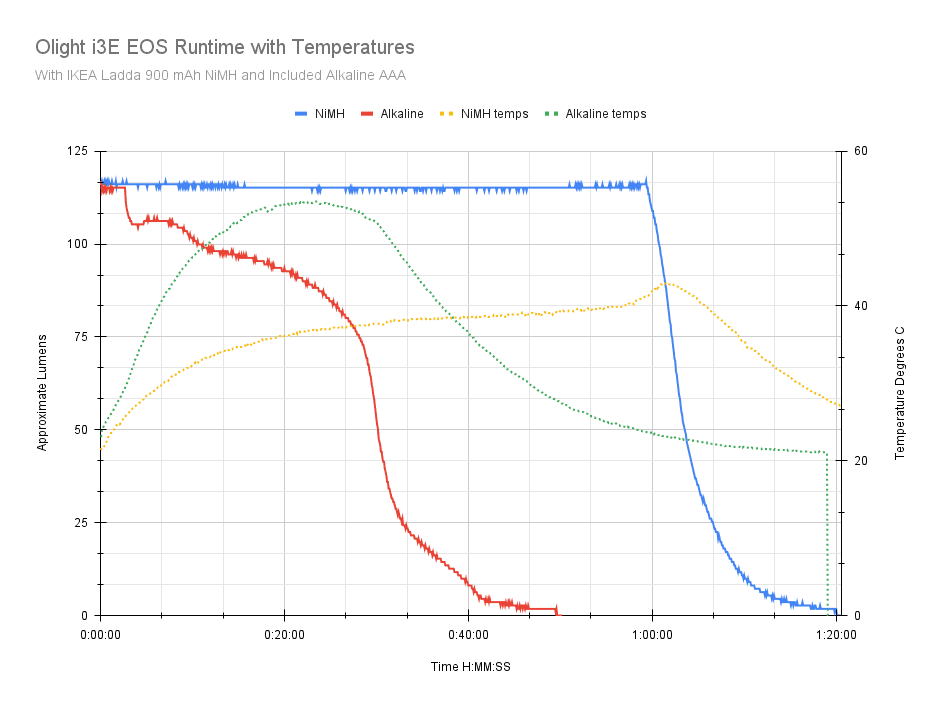
No issues with the runtimes, and once again, the output tracks with the advertised specs. The output on the NiMH is nice and flat for nearly the entirety of the runtime, with laminar output of around 110 Lumens until an abrupt ramp down until turn off.
The Alkaline cell starts strong, but only maintains regulated output for about 3 minutes before behaving like a FET-driven light. The Alkaline cell holds a higher initial voltage, which helps with higher output, but the cell’s higher internal resistance and lower capacity causes the output to drop more quickly.
The NiMH has a higher capacity and is able to maintain output better without the voltage sagging, which keeps the driver in regulation longer. Temperatures were kept in check and never crested above 50 C at the head, and only on the Alkaline cell. It was still comfortable to hold for the entirety of the runtime.
For the comparison, I grabbed some of the popular keychain and pocket lights out there. Outputs varied based on the cells used. While some others got brighter, the i3E EOS did great and for the size to performance ratio, I don’t think you can do better than this. Only the Fenix E-Lite does better here in the tiny keychain light category.
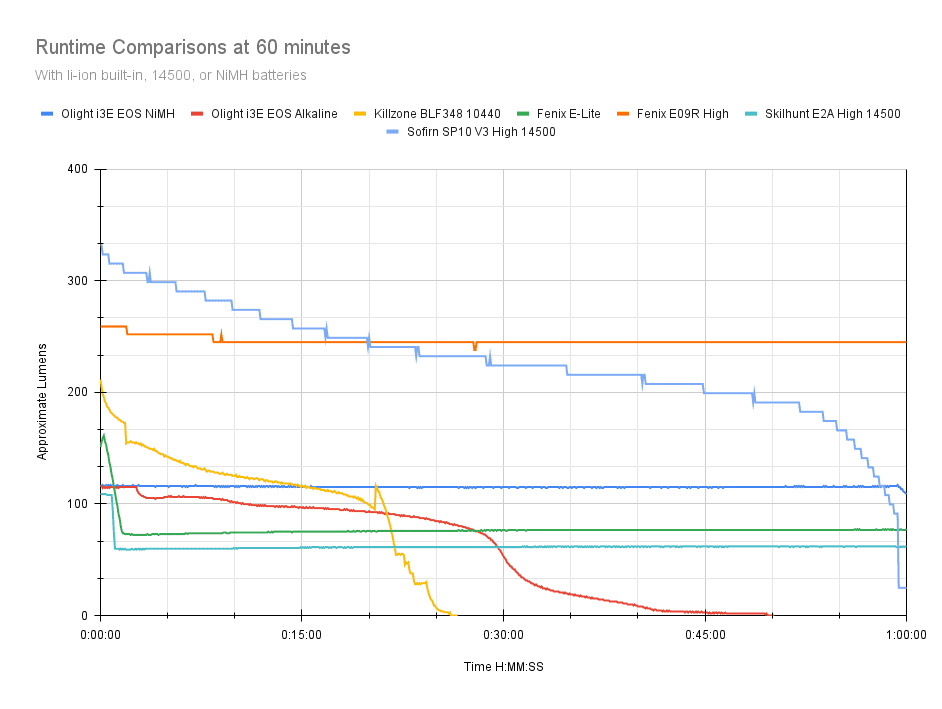
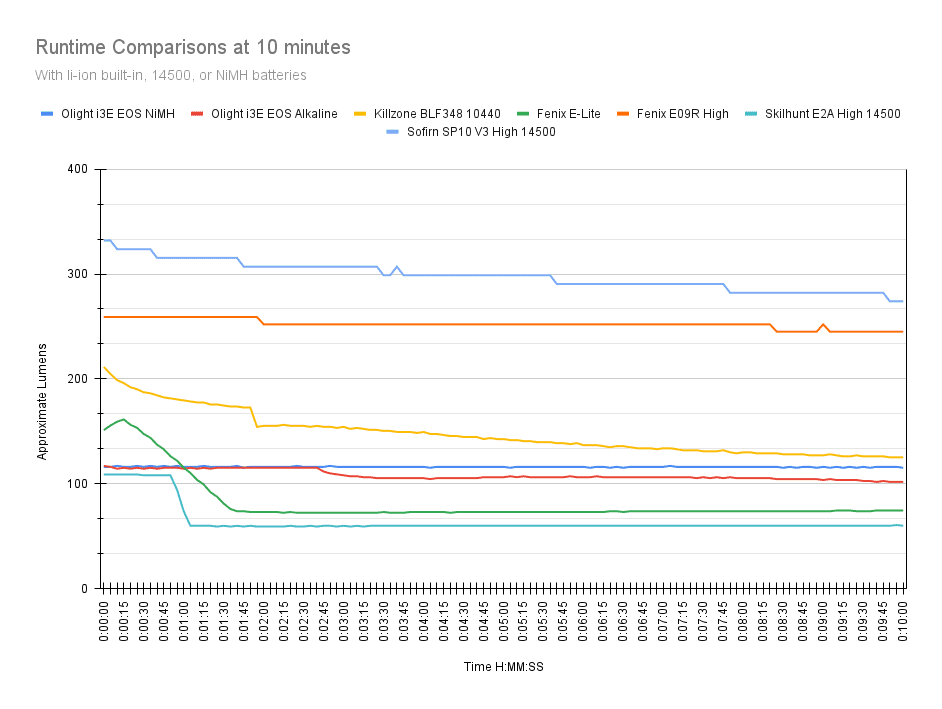
Peak beam intensity and beam distance measurements
About Peak beam intensity: Understanding ANSI FL1 Standards About peak beam intensity The calculated value of distance in meters at which the flashlight produces a light intensity of 0.25 lux. (0.25 lux is about the brightness of a full moon shining on an object). This means that the intensity has decreased so much, it becomes difficult to see darker objects, or objects that don’t reflect light. The columns ‘Meters’ and ‘Yards’ use rounded numbers.Beam distances are measured using a Uni-T UT383S luxmeter measured indoors at 5 meters using the included Alkaline battery and an IKEA Ladda NiMH. Measurements taken at 30 seconds.
| Mode | Specs | Candela measured | Meters | Yards |
|---|---|---|---|---|
| On IKEA Ladda 900 mAh NiMH | ? | 575 cd | 48 | 52 |
| On included generic alkaline | 500 | 550 cd | 47 | 51 |
The beam distance and intensity figures also track the Olight specs. This is more than enough beam distance for emergencies or poking around in dark places under car seats, fumbling for keys, door locks, etc.
Beamshots
Camera settings and distance: Photos taken with my Canon EOS R100 with a Canon 18-45mm IS STM lens. The camera is set to ISO, 0.3s, and manually-set 5000K WB.
Beamshots of the following keychain flashlights compared:
- Olight i3E EOS
- Fenix E-Lite
- Olight i1R 2 Pro
- Olight i3T EOS
- Cyansky M2
- Ozark Trail OL50 (3xAAA from WalMart)
- Thorfire PF01
- Fenix E09R
Please note that the following beamshots are mainly intended to showcase the beam pattern and beam quality, rather than overall performance. These images are typically taken directly after activation, and in different seasons or weather conditions, and therefore do not fully represent its overall performance. For accurate performance metrics, such as output, beam distance, and runtimes, you need to look at the performance section of this review.
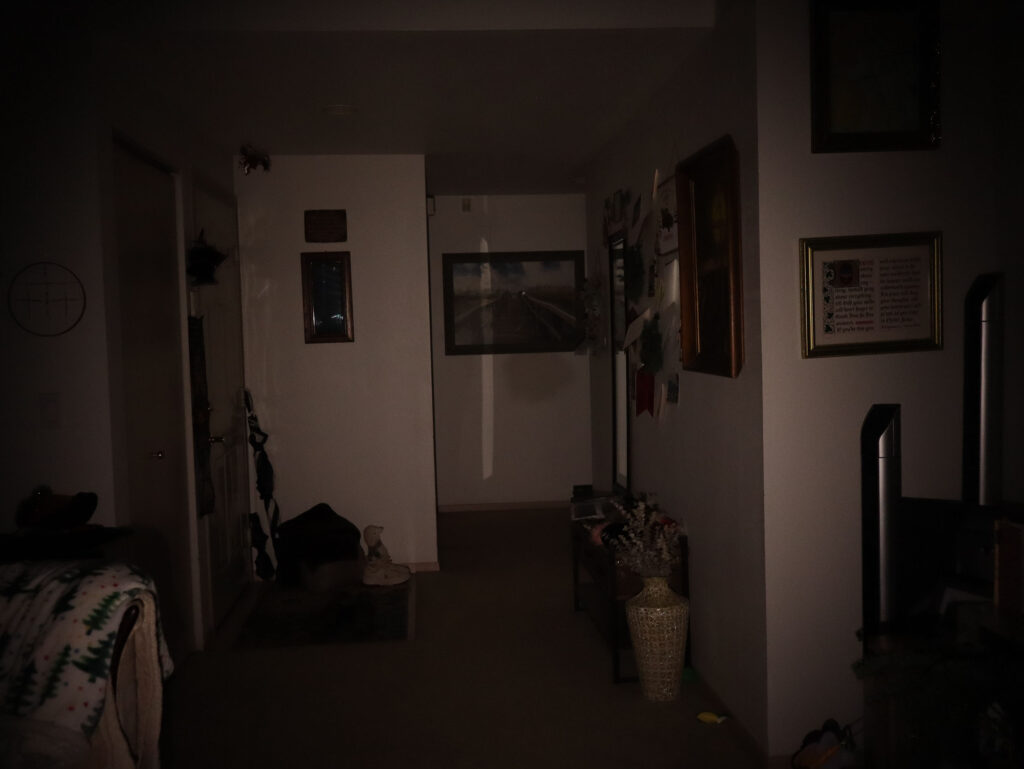
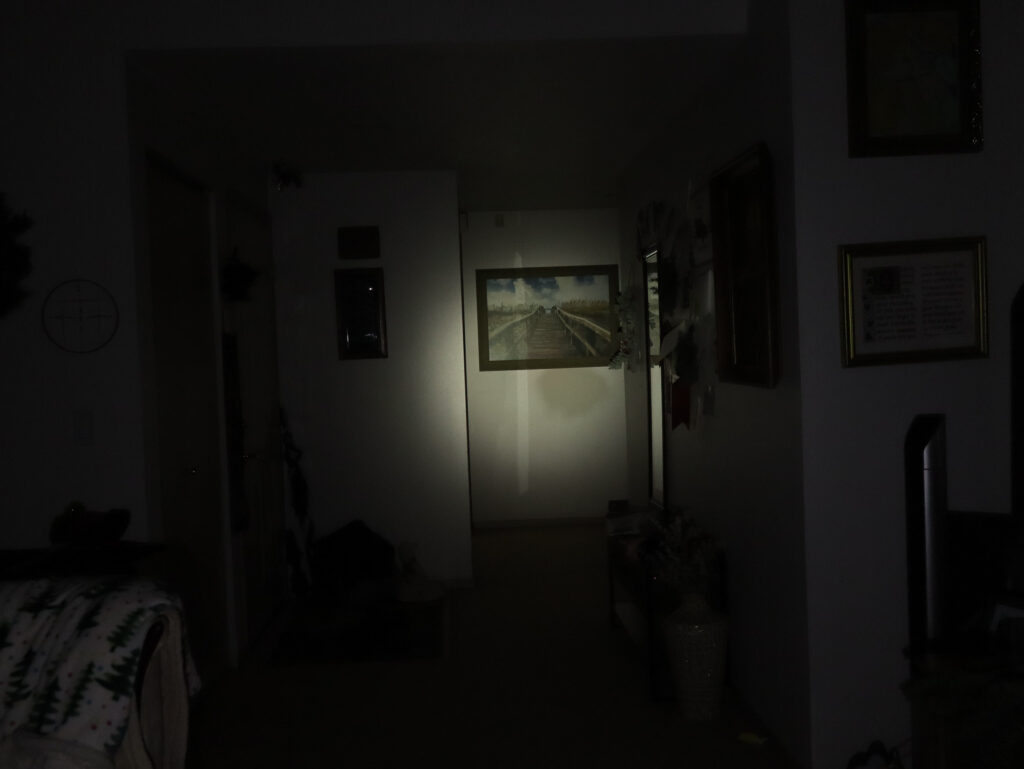
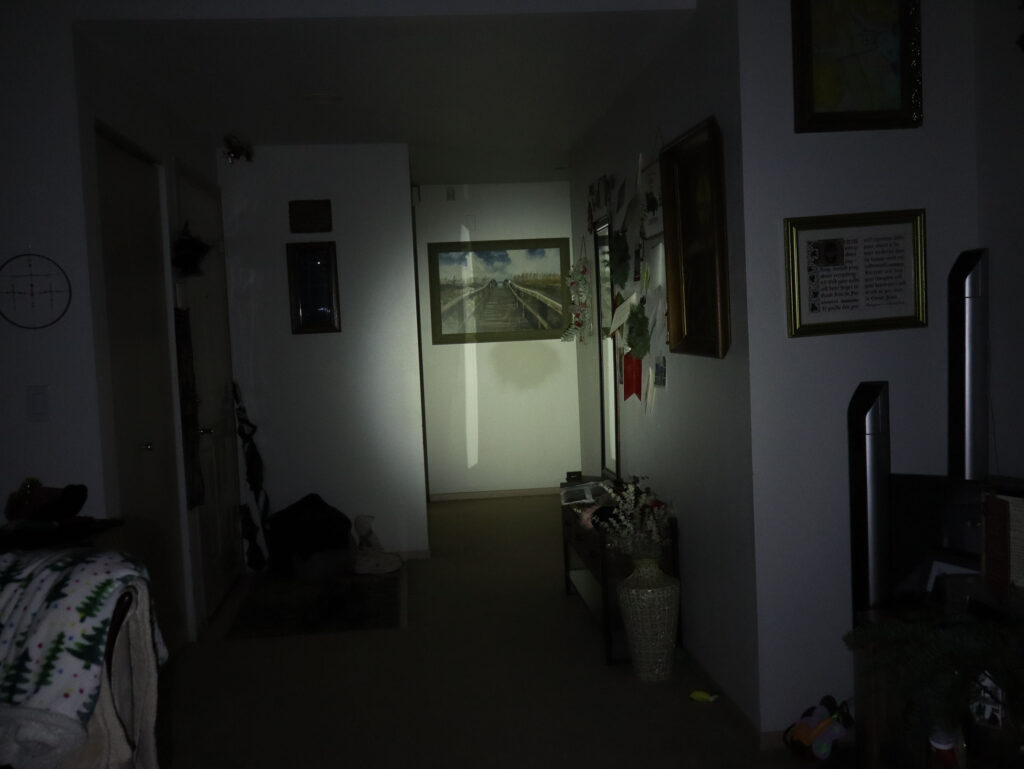
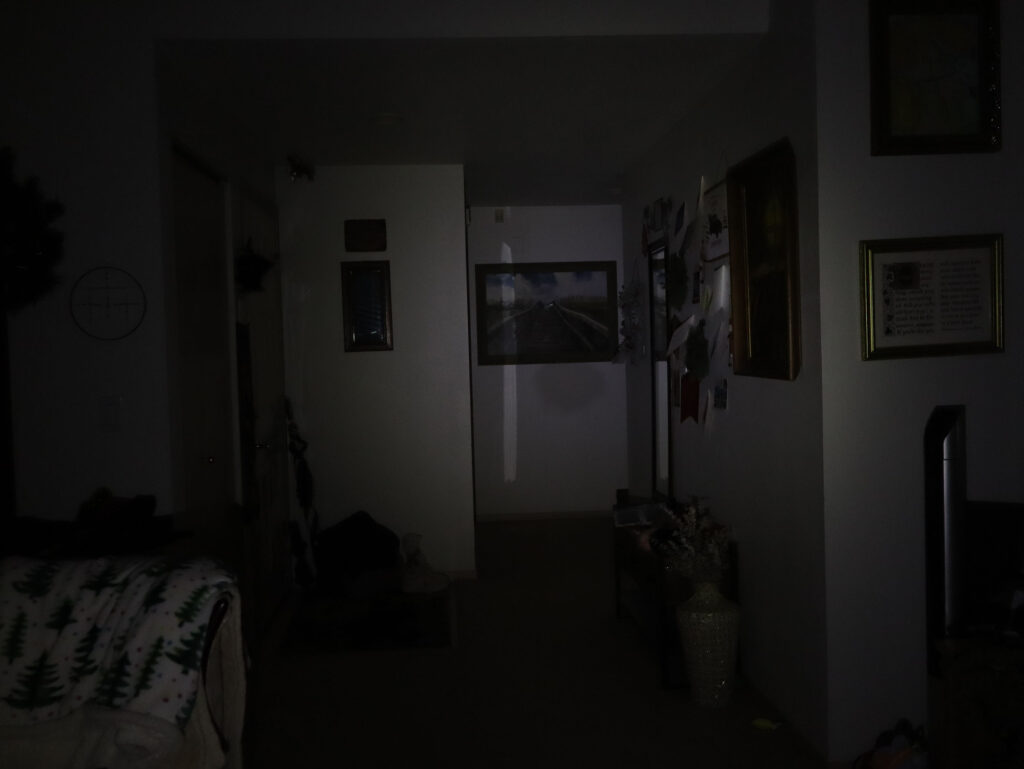
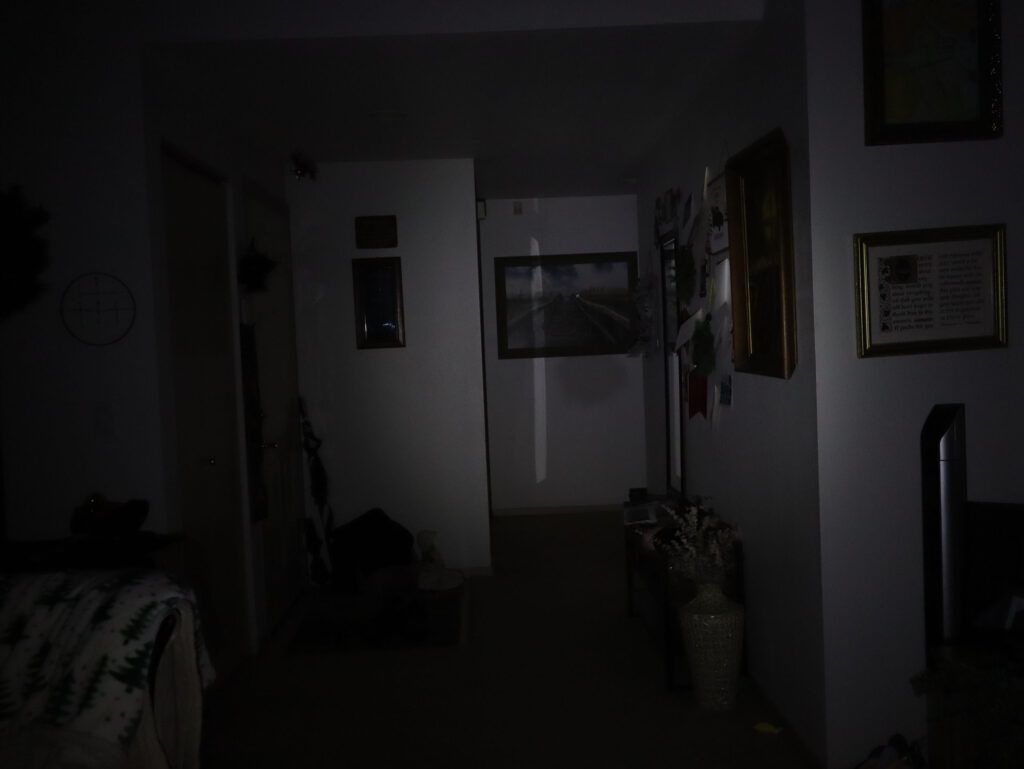


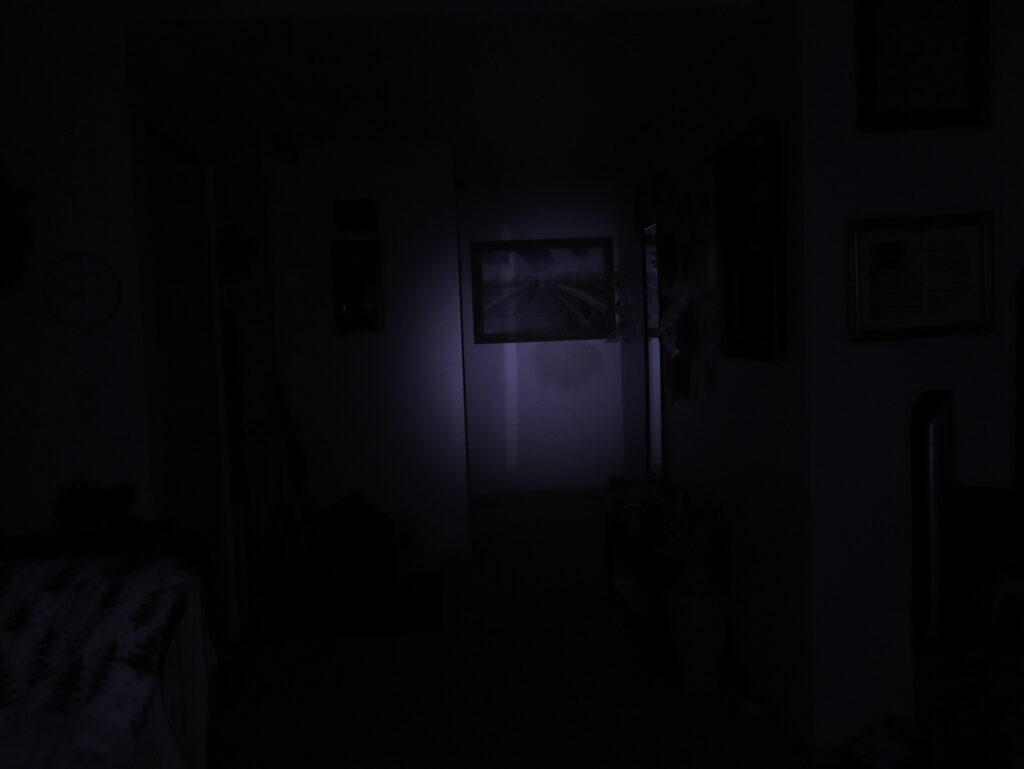
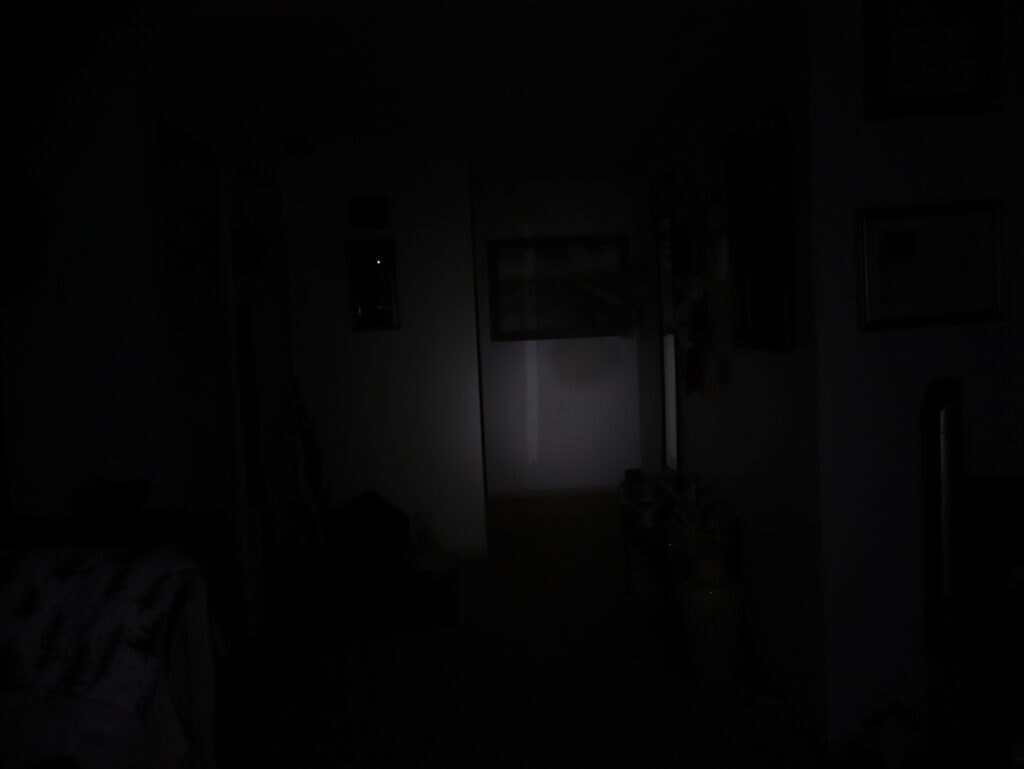
Disclaimer: This flashlight was sent to us for review at no cost by Olight. We have not been paid to review, nor have we been holding back on problems or defects.
Final Verdict
Pros
- Excellent build quality, fit and finish
- Extremely high size to output ratio
- Cheap (in a good way)
- Takes AAAs of all types
- Simple operation
- Durable
Cons
- Finish gets ruined after a while on the keychain under normal use
- Single mode only
Explanation on star ratings:
1: Avoid: a match would be a better choice – 2: Poor: significant defect or issues; almost unusable – 3: Average: some defects or issues; but still usable 4: Good: recommended (minor issues) – 5: Great: highly recommended

5 stars: ★★★★★
While our star rating provides a reliable indicator, we encourage you to read the full review to make an informed decision based on your own needs and preferences.
Olight does it again with another ringer, this time without resorting to exotic finishes, ultra high power LEDs, or flashy features. I think it’s mission accomplished here, since the i3E EOS is about as simple and effective as it gets for tiny flashlights. It’s versatile, using readily available AAA batteries. It’s also easy to use one-handed, and it’s perfect for keychain duty since it can take some abuse and keep going without being heavy.
My wife totes around the Olight i1R 2 Pro, and I actually prefer the i3E because it’s much lighter.
As a rule, it’s advisable to avoid putting heavy items on your car keys since the added weight over time can damage the lock tumbler and ignition switch (trust me, you don’t want that). Having a powerful (for its size) light that doesn’t take up a lot of real estate on your keyring is a blessing.
There’s a lot to love here, but keeping it objective, if I could nit pick this thing, I’d only knock it for the fact that the finish gets grenaded after about 6 months of keyring duty.
Olight, if you’re listening, maybe offer a bare aluminum (or titanium?) version. I’d buy one…or three. Maybe even offer a high CRI 5000K version while you’re at it. I digress though because you really can’t go wrong with this thing. It’s light, small, and more importantly, performs. The only reason I’m using the Fenix E-Lite over this is the fact it doesn’t have a finish to wear off. Don’t get me wrong, this isn’t a replacement or an AA/14500 light like a Sofirn SP10 V3, Skilhunt E2A, or Skilhunt M150, but for a dinky thing, it’s really good. 5 stars for the i3E EOS.
Buy your Olight i3E EOS at a discount
Use our exclusive 1lumen discount code to get an extra 10% off anything you order at Olightstore.com (USA). Coupon code: 1lumen
1lumen selects and reviews products personally. We may earn affiliate commissions through our links, which help support our testing.